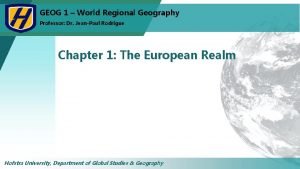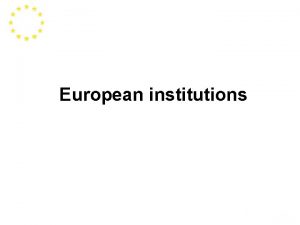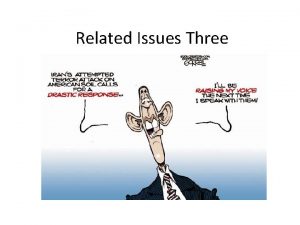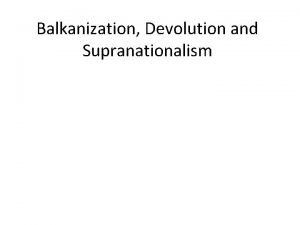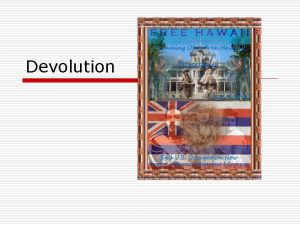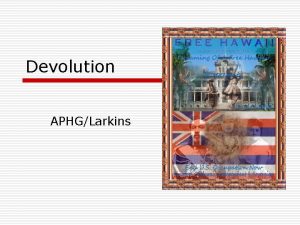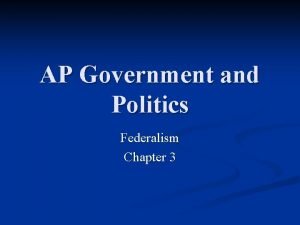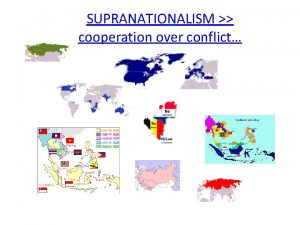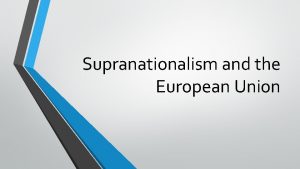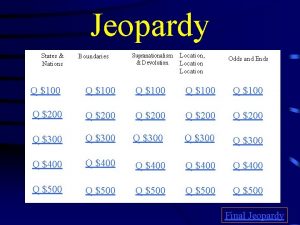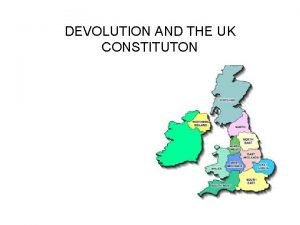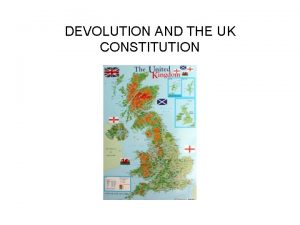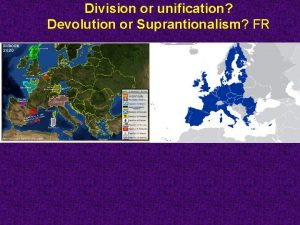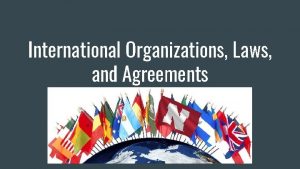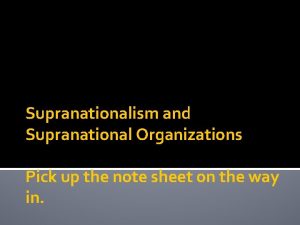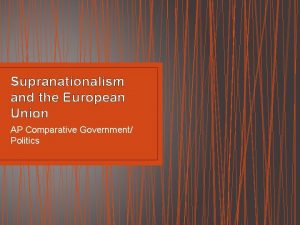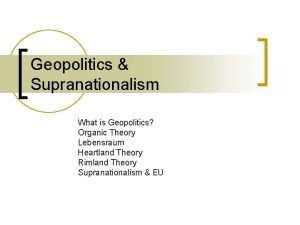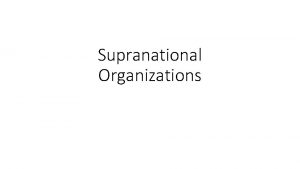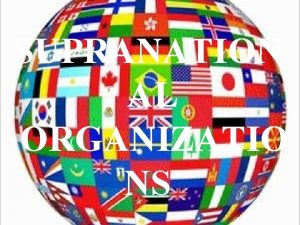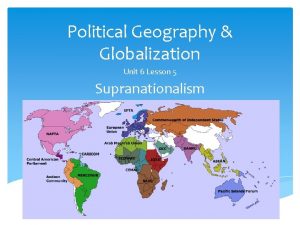SUPRANATIONALISM AND DEVOLUTION DEVOLUTION AND SUPRANATIONALISM The modern























- Slides: 23

SUPRANATIONALISM AND DEVOLUTION

DEVOLUTION AND SUPRANATIONALISM The modern world is divided into a system of states. Those states are in a constant struggle between two forces. DEVOLUTION SUPRANATIONALISM Operates in three senses: Supranationalism is the act of states forming joint groups: 1. In a centralized government, the relinquishing of autonomy to internal units (ex: US) 2. The process where regions within a state demand gain political strength/autonomy at the expense of the central government (ex: Denmark, Belgium, UK, Canada, Spain) 3. The breakup of a state due to irreconcilable differences between cultural groups (balkanization) (ex: USSR, Yugoslavia, Czechoslovakia, Ethiopia/Eritrea, India) 1. political, economic and/or cultural cooperation among states to promote shared objectives. 2. The tendency of states to give up power to a higher authority in pursuit of common objectives (political, economic, military, environmental) Whereas devolution often indicates an inability to get along, suprantionalism involves greater cooperation between diverse states.

EMERGENCE OF SUPERPOWERS During the Cold War Era (1940 s to 1991), countries established global / regional organizations to help prevent a third world war and to stimulate trade in a globalizing world. The division of the world into regional military alliances resulted in the emergence of two states (the US and the USSR) as superpowers. Most states then joined alliances with either the US (in NATO) or the USSR (In the Warsaw Pact).

Some key elements in EU integration Free trade among member states Remove barriers to movement of labor & capital Uniform fiscal & environmental policies EU Members 15 members joined 1958 -1995 12 newest members joined 2004 -2007 Candidate countries

THE EUROPEAN UNION AND THE EUROZONE Since its inception, the EU has grown to 27 member countries. Its main objective is to create development in member states through economic and political cooperation. The Euro is a currency created by the EU and intended to replace the individual currency of EU member nations. The Eurozone is the group of countries who have adopted that currency, and it includes 17 EU members and 6 other countries. There is a jointly elected European Parliament, and the EU provides subsidies to farmers and depressed regions. The EU has also removed most barriers to free trade. Adoption of the Euro proved to be an economic boon for Euroozone countries until the 2008 global recession (caused by a collapse of the US housing market). Citizens of member countries are allowed to move freely between countries as well as work and own property in other countries. As unsound spending and lending practices of Portugal, Italy, Ireland, Greece and Spain (PIGS) have come to light, the Euro and Eurozone have been unstable.

Factors Leading to Devolution • Physical Geography – mountains, islands, peninsulas. (ex – Philipines)

• Ethnic Separatism (Basques, Kosovars)

• Ethnic Cleansing (Serbs vs everyone)

• Terrorism – (Southern Thailand)

• Economic and Social Problems (Northern Italy vs. Southern Italy) – South called Mezzogiorno – Lowest economy in the EU – North wants to separate

• Irredentism

CONSEQUENCES IN EUROPE DEVOLUTION Numerous states exist where fewer existed before. Many governments are decentralized with more power to regions. Re-emergence of ethno-nationalism. Regional separatism rather than unity. Increased political instability (fighting, civil war, ethnic cleansing, etc. ) SUPRANATIONALISM Larger market for member nations (more trade, free trade, reduced tariffs, more prosperity) Enhanced international influence for member countries as a part of the whole. Open borders for labor and tourists. Common currency (the Euro). Economic instability. Common policy and less control over individual policy (resources, agriculture, economy, environment, trade, military). Mass migrations through refugees and emigration. Loss of national identity, enhanced international peace.




Communication Technology • Advances in communication technology have facilitated devolution, supranationalism, and democratization.

end

SUPRANATIONAL COOPERATION When the USSR devolved in 1991, the Cold War and the period of two super powers ended The world has returned to a pattern of numerous superpowers, and the most important element of state power is more economic than military. States do still cooperate militarily, however: POLITICAL/MILITARY United Nations (UN)… “maintaining international peace and security, developing friendly relations and promoting social progress, better living standards and human rights. ” North Atlantic Treaty Organization (NATO)… “to safeguard the freedom and security through political and military means… consulting and cooperating in the fields of security and defense. ” Organization on Security and Cooperation in Europe (OSCE)… “forum for political negotiations and decision-making in the fields of early warning, conflict prevention, crisis management and post-conflict rehabilitation. ” Organization of American States (OAS)… “an order of peace and justice, to promote their solidarity, to strengthen their collaboration, and to defend their sovereignty, their territorial integrity, and their independence. ” African Union (AU)… economic integration of African states. The Commonwealth… economic and cultural cooperation between the UK and former colonies

SUPRANATIONAL COOPERATION Since the USSR dissolved in 1991, the world has returned to a state of more than two superpowers. In the wake of the cold war, the most important element of state power is economic, not military. The leading superpower is now a union of European states. ECONOMIC European Union (EU)… a single market union of 27 European states with a common currency designed to foster trade and reduce conflicts in the region. North American Free Trade Agreement (NAFTA)… an agreement to create a free trade zone between the US, Canada and Mexico. Association of Southeast Asian Nations (ASEAN)… “To accelerate the economic growth, social progress and cultural development in the region through joint endeavours in the spirit of equality and partnership in order to strengthen the foundation for a prosperous and peaceful community of Southeast Asian Nations” Economic Cooperation Organization (ECO)… “an intergovernmental regional organization established in 1985 by Iran, Pakistan and Turkey for the purpose of promoting economic, technical and cultural cooperation among the Member States. In 1992, the Organization was expanded to include seven new members, namely: Islamic Republic of Afghanistan, Republic of Azerbaijan, Republic of Kazakhstan, Kyrgyz Republic, Republic of Tajikistan, Turkmenistan and Republic of Uzbekistan. ” Mercado Común del Sur (MERCOSUR)… an economic and political agreement among various Latin American countries to promote free trade, and the fluid movement of good, people and currency between member states. Community of Latin American and Caribbean States (CELAC)… a regional bloc of all countries in the Americas except the US, Canada and European dependencies designed to counter the political and economic influence of the US in the region and of the US run OAS.

TERRORISM

TERRORISM is the systematic use of violence by a group in order to intimidate a population or a government into granting that group’s demands. Terrorism is distinct from war in that terrorists are often not associated with any uniformed military and do not act as soldiers under a formal declaration of war. Terrorists use fear-based tactics like bombings, kidnapping, hostage-taking and assassinations. Terrorists consider their violence necessary as a means for addressing their grievances. Distinguishing terrorism from other acts of political violence can often be difficult.

TERRORISTS Terrorism can be perpetrated by individuals (Timothy Mc. Veigh, the Unabomber) or by groups (Al Qaeda). Terrorists can be funded by individuals, groups or states (Libya, Afghanistan, Pakistan, Iran, etc. ) While a state cannot officially be classified as a terrorist organization, it can support terrorists in a number of ways: --Providing sanctuary --Providing weapons, money or intelligence --Black Flag Operations (planning attacks using terrorists)

RECIPES FOR UNREST As we saw in the religion and ethnicity units, minority groups will often resort to violence either to defend themselves against larger groups in power or to gain autonomy for themselves in their core regions. Highly fragmented areas, areas of high heterogeneity (balkanized) regions are prone to be conflict zones.
 Jean-paul rodrigue
Jean-paul rodrigue Supranationalism vs intergovernmentalism
Supranationalism vs intergovernmentalism Definition of economic stability
Definition of economic stability Balkanization and devolution
Balkanization and devolution Ethnocultural devolutionary movements
Ethnocultural devolutionary movements Cairo conference definition ap human geography
Cairo conference definition ap human geography Devolution aphg
Devolution aphg Devolution ap gov
Devolution ap gov Cornwall devolution deal
Cornwall devolution deal Hình ảnh bộ gõ cơ thể búng tay
Hình ảnh bộ gõ cơ thể búng tay Frameset trong html5
Frameset trong html5 Bổ thể
Bổ thể Tỉ lệ cơ thể trẻ em
Tỉ lệ cơ thể trẻ em Voi kéo gỗ như thế nào
Voi kéo gỗ như thế nào Chụp phim tư thế worms-breton
Chụp phim tư thế worms-breton Hát lên người ơi alleluia
Hát lên người ơi alleluia Các môn thể thao bắt đầu bằng tiếng chạy
Các môn thể thao bắt đầu bằng tiếng chạy Thế nào là hệ số cao nhất
Thế nào là hệ số cao nhất Các châu lục và đại dương trên thế giới
Các châu lục và đại dương trên thế giới Công thức tính thế năng
Công thức tính thế năng Trời xanh đây là của chúng ta thể thơ
Trời xanh đây là của chúng ta thể thơ Mật thư tọa độ 5x5
Mật thư tọa độ 5x5 Làm thế nào để 102-1=99
Làm thế nào để 102-1=99 Phản ứng thế ankan
Phản ứng thế ankan
